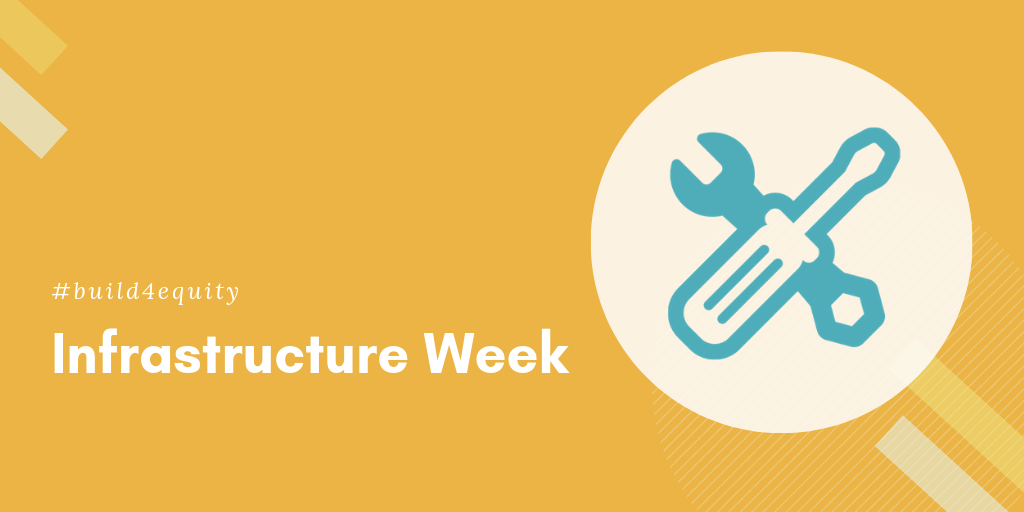
National Infrastructure Week – Five Recommendations to Create Equitable Infrastructure Investments

At PolicyLink, we know that smart, targeted, equitable investments in infrastructure can have a transformative impact on low-income communities and communities of color. That’s why we are excited to join infrastructure advocates throughout the nation, for National Infrastructure Week—a time to collectively garner more public awareness and advocacy to support increased investments in infrastructure.
This week we will be posting a new blog each weekday exploring infrastructure equity. We encourage you to share our blog posts with your network and follow the conversation on Twitter using the hashtag #Build4Equity and #BuildForTomorrow -- the official infrastruture week hashtag.
Five Recommendations to Create Equitable Infrastructure Investments
Infrastructure can provide transformative benefits to communities, but the story of infrastructure in the United States has often been devastating for Indigenous people, people of color, and low-income communities. From the transcontinental railroads that destroyed native lives and accelerated European occupation, to the demolition of entire communities in the mid-20th century spurred by urban renewal and freeway expansion, to the ongoing pattern of locating pollution generating infrastructure and industry in neighborhoods that are home to low-income people and people of color, to the persistent lack of investment that has left millions of people in urban and rural communities without safe drinking water, sidewalks, parks, or other critical infrastructure—for too many people, infrastructure has been an oppressive force. A way to consolidate wealth and power for some while reinforcing racial and economic exclusion.
Today, we have an opportunity to change this. Our infrastructure is in serious need of attention. Growing populations, resource-intensive development patterns, new technology requirements of a rapidly changing economy, and several decades of underinvestment have combined to create a huge backlog of infrastructure projects all over the country—in urban, suburban, and rural areas. According to the American Society of Civil Engineers, we have to spend an additional $500 billion a year between now and 2040 in order to close our infrastructure gap. This backlog combined with the clear evidence that our existing infrastructure is not serving the communities who will soon constitute the majority, and the growing impacts of climate change, creates an opportunity for us to step out of our past and radically reimagine how we plan for, build, and maintain our infrastructure systems.
Here are five recommendations that can set us in the right direction:
- Serve underinvested communities without pushing out existing residents. Rectifying decades of disinvestment in communities of color and low-income neighborhoods is critical, but making these investments without protecting residents from displacement will only exacerbate harm. The benefits of infrastructure investments should be targeted to those with the greatest need and should be combined with strategies to ensure that residents can stay in their communities.
- Improve the environmental health and quality of life for residents of disinvested places. Climate change demands transformation in every aspect of our lives. As we tackle the next generation of infrastructure that will allow us to both slowdown climate change and prepare for its impacts, we have an opportunity to substantially improve the health and quality of life for residents of disinvested places. From electrification of our goods movement infrastructure, to redesigning our neighborhoods for multi-modal mobility, our transition to clean energy can provide a host of co-benefits to communities.
- Be equitably owned, financed, and funded. How infrastructure projects are owned, financed, and funded, affects whether they advance or impede equity. Ownership and financing should be structured to put greater power in low-income communities and communities of color and should ensure that project benefits actually make it to them.
- Create good jobs and business opportunities for local residents. While infrastructure investments can facilitate a host of physical improvements in a community, they can also provide workforce development opportunities, jobs, and new business opportunities. Making sure that these economic benefits are accessible to a broad cross section of local residents, including individuals with barriers to employment, will ensure that our infrastructure investments contribute to a future of shared prosperity.
- Include residents in decision-making at every step. Achieving equity requires shared decision-making that is rooted in transparency and a commitment to changing inequitable policies and practices. Bringing communities into all stages of infrastructure planning and implementation allows for community knowledge and priorities to shape decisions and ultimately leads to better projects and outcomes.
Over the next four days we will explore these recommendations further and will join our partners from around the country to reimagine infrastructure so that we can #Build4Equity and #BuildForTomorrow.

